The Colosseum is probably the most impressive building of the Roman empire. Originally known as the Flavian Amphitheater, it was the largest building of the era.
The monumental structure has fallen into ruins, but even today it is an imposing and beautiful sight.
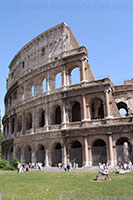
Emperor Vespasian, founder of the Flavian Dynasty, started construction of the Colosseum in AD 72. It was completed in AD 80, the year after Vespasian's death.
The huge amphitheater was built on the site of an artificial lake, part of Nero's huge park in the center of Rome which also included the Golden House (Domus Aurea) and the nearby Colossus statue. This giant statue of Nero also gave the building its current name.
The huge amphitheater was built on the site of an artificial lake, part of Nero's huge park in the center of Rome which also included the Golden House (Domus Aurea) and the nearby Colossus statue. This giant statue of Nero also gave the building its current name.
The Building
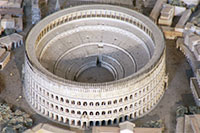
The Colosseum in Imperial Rome
Above the ground are four storeys, the upper storey contained seating for lower classes and women.
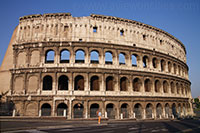
Velarium
The Colosseum was covered with an enormous awning known as the velarium. This protected the spectators from the sun. It was attached to 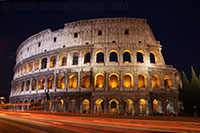 large poles on top of the Colosseum and anchored to the ground by large ropes. A team of some 1,000 men was used to install the awning.
large poles on top of the Colosseum and anchored to the ground by large ropes. A team of some 1,000 men was used to install the awning.

Bread and circuses
Emperors used the Colosseum to entertain the public with free games. Those games were a symbol of prestige and power and they were a way for an emperor to increase his popularity.
Games were held for a whole day or even several days in a row. They usually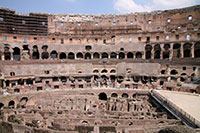 started with comical acts and displays of exotic animals and ended with fights to the death between animals and gladiators or between gladiators. These fighters were usually slaves, prisoners of war or condemned criminals. Sometimes free Romans and even Emperors took part in the action.
started with comical acts and displays of exotic animals and ended with fights to the death between animals and gladiators or between gladiators. These fighters were usually slaves, prisoners of war or condemned criminals. Sometimes free Romans and even Emperors took part in the action.
Games were held for a whole day or even several days in a row. They usually

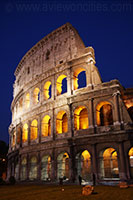
Hundred-day games were held by Titus, Vespasian's successor, to mark the inauguration of the building in AD 80. In the process, some 9,000 wild animals were slaughtered.
The Ruins
The southern side of the Colosseum was felled by an earthquake in 847. Parts of the building - including the marble facade - were used for the construction of later monuments, including the St. Peter's Basilica
.
No comments:
Post a Comment